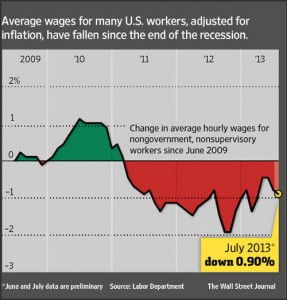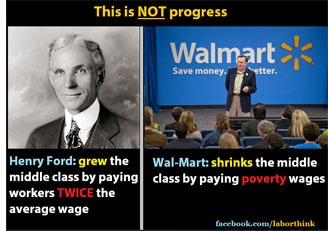OPINION
Wall Street Journal can’t connect the dots on jobs, wages, unions
 By DAVID GROVES
By DAVID GROVES
SEATTLE (Aug. 28, 2013) — Monday’s edition of The Wall Street Journal included two stories about jobs and wages that provide a concise summary of what’s wrong with America and what’s right with Seattle. However, the business-minded newspaper failed to connect the dots between the articles, perhaps because doing so would directly contradict its right-wing conservative editorial agenda.
Allow me.
“Four years into the economic recovery, U.S. workers’ pay still isn’t even keeping up with inflation,” the Journal reports. “The average hourly pay for a nongovernment, non-supervisory worker, adjusted for price increases, declined to $8.77 last month from $8.85 at the end of the recession in June 2009.”
 The article doesn’t get into the social implications for American families and their quality of life. After all, this is The Wall Street Journal. Instead, it concludes that the economy can be expected to remain sluggish because suppressed wages — which the Journal’s go-to economists blame on persistent unemployment and globalization — means lower consumer spending.
The article doesn’t get into the social implications for American families and their quality of life. After all, this is The Wall Street Journal. Instead, it concludes that the economy can be expected to remain sluggish because suppressed wages — which the Journal’s go-to economists blame on persistent unemployment and globalization — means lower consumer spending.
The word “union” does not appear in the report. Many economists agree that the decline in unionization and workers’ resulting loss of bargaining power over wages is a key factor in Americans’ shrinking paychecks. But that doesn’t merit a mention in the Journal.
Meanwhile, elsewhere in Monday’s edition is a report hailing Seattle as a national leader in job growth.
The secret to Seattle’s success is its mix of industries — a combination of technology, service and manufacturing that have hired more readily than those other parts of the country. Seattle has added factory jobs at a rate nearly four times as fast as the rest of the U.S. in the past two years. Retail and construction jobs have grown more than twice as fast.
But wait a second. A lot of the new jobs highlighted in that report, like those at Boeing, among shipbuilders and on the downtown tunnel project, are good-paying unionized jobs. In fact, Washington state has the 4th highest union density in the nation and personal income is significantly higher here. And yet, Boeing profits are strong, driven by its Washington-based commercial airplane manufacturing, and unionized shipbuilders like Vigor Industrial are thriving and growing.
While many states with anti-union right-to-work (for less) laws — which the Journal aggressively champions — continue to struggle with low wages and high unemployment, heavily unionized high-wage Seattle’s unemployment rate is 5.9% and Washington state’s is 6.8%. The national rate is 7.6%.
In addition to “union,” neither Journal report mentions the minimum wage. The federal minimum has been stuck at $7.25 an hour for the past four years and is likely to remain there as long as conservative Republicans control the U.S. House of Representatives. Surely, that’s a fact relevant to a report about Americans’ suppressed wages, no?
Seattle and the rest of Washington state enjoy the highest minimum wage in the nation at $9.19 per hour, thanks to a popular citizen’s initiative that automatically increases it each year to adjust for inflation. Today, between 15 million and 20 million Americans are paid wages so low, they would be illegal in Washington. Such laws are abhorrent to the Ayn Randers at the Journal, but it’s working out pretty well here, not only in Seattle but also in Washington towns along the border with Idaho, where the minimum wage is $2 less.
Washington’s higher minimum wage and good-paying union jobs are putting money in people’s pockets, which is being spent at local businesses and boosting the state’s economy. It’s a success story about the positive economic impact of organized labor and wage standards that respect work and families. But don’t expect the anti-union free-market ideologues at The Wall Street Journal to connect those dots.
 Like Henry Ford, who famously doubled his workers’ wages in 1914 so they could afford to buy the cars they were making, the Journal seems to understand that working people need to have money in their pockets for America’s economy to grow.
Like Henry Ford, who famously doubled his workers’ wages in 1914 so they could afford to buy the cars they were making, the Journal seems to understand that working people need to have money in their pockets for America’s economy to grow.
What they still don’t get is that, in this era of Wall Street and Walmart, there are no more Henry Fords who see the long-term benefit to their companies — and their nation — of paying middle-class wages. Today’s largely unregulated market is driven by short-term share prices and, by its very nature, engages in a race to the bottom on jobs and wages. It doesn’t care about Americans’ standard of living, and frankly, it doesn’t care about America. It cares only about profits and employing the fewest number of people who are paid as little as you can possibly get away with.
That’s why unions and the government play such an important role in America. And that’s why The Wall Street Journal — and a lot of the powerful people who read it — should stop treating both like they are the enemy.
David Groves is the Editor of the Stand. He can be reached at david.groves@thestand.org.





